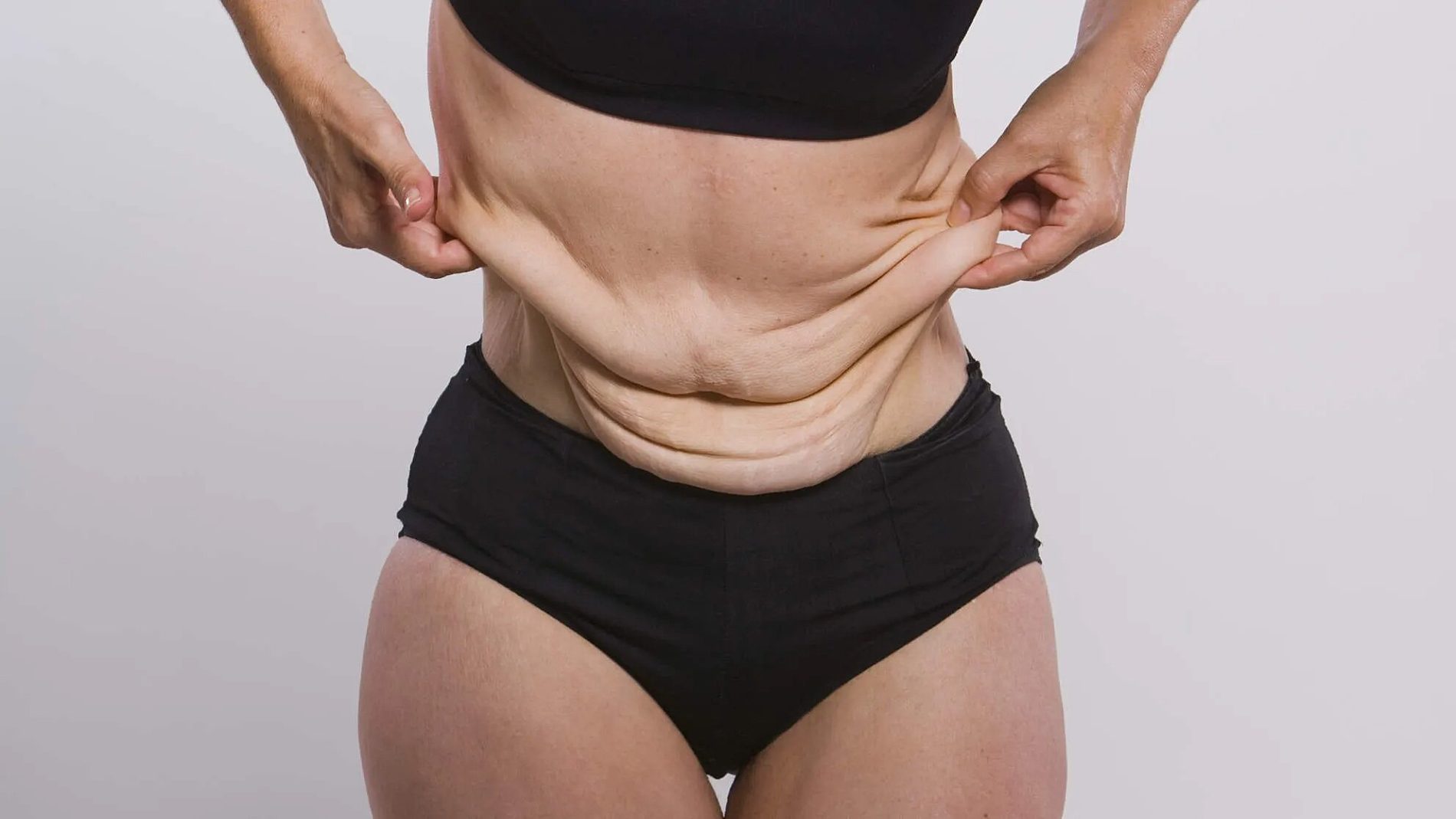Losing a lot of weight is a notable accomplishment, not to mention, it translates to a healthier lifestyle.
If you have lost weight or are looking to lose weight, one of your concerns may be loose skin. Like excess weight, sagging skin can be just as frustrating and have an impact on your self-esteem.
Fortunately, there are ways to tighten loose skin.
What causes loose skin after weight loss? How do you get rid of the excess skin? Read on to find out.
Causes of Loose Skin after Weight Loss
Loose skin is caused by losing a considerable amount of weight, (100 pounds or more) within a short period. Why? Weight gain causes your skin to stretch. If your skin remains in this state for an extended period, its collagen and elastin fibers get damaged.
Consequently, when you drastically lose weight, your skin does not have enough elasticity to contract back down to your new, smaller body.
Most people who are obese or overweight carry excessive pounds for years. As a result, when they undergo massive weight loss, they are left with loose skin.
Note: collagen and elastin are proteins in the dermis, i.e., the innermost layer of the skin. Collagen gives your skin strength and firmness, while elastin provides elasticity and helps keep your skin tight.
Factors that Influence the Loss of Skin Elasticity
Several factors before and after weight loss contribute to loosen skin. These include:
- Length of time overweight: the longer you have had excessive body fat, the looser your skin will be after shedding off those extra pounds due to elastin and collagen loss
- Amount of weight lost: losing 100 pounds (46 kilograms) or more within a short time typically results in more pronounced loose skin.
- Age: Older people, i.e., 50 years of age and above, tend to have more loose skin following weight loss since their skin has less collagen and elastin than younger people’s skin. Consequently, their skin is less able to retract to their new body size.
- Smoking: if you smoke, you are at a higher risk for sagging skin than a non-smoker. The reason being, smoking reduced collagen synthesis and damages existing collagen.
- Genetics: your genes may determine how firm and elastic your skin will be after weight loss.
- Sun exposure: prolonged sun exposure results in reduced collagen and elastin production, resulting in loose skin.
- Nutrition: your skin needs the right balance of nutrients to remain healthy.
Problems Related to Excess Loose Skin
If you have lost significant weight, having loose skin is a normal and common side effect. Common locations you may experience loose skin include the:
- Abdomen
- Upper arms
- Thighs
- Buttocks
- Face
- Neck
Loose skin following significant weight loss is not only frustrating but may also lead to physical and emotional challenges, such as:
- Decreased physical activity: a study of the impact of excess skin on the practice of physical activity in women found that 76.9% of the 26 women studied reported limited mobility due to loose skin. Moreover, 45.2% avoided exercising altogether because the excess skin would flap, causing people to stare.1
- Physical discomfort: excess skin can cause discomfort to the point of interfering with everyday physical activity. In the study of 360 adults (110 men and 250 women), this problem was mostly experienced by patients who had lost 110 pounds (50 kilograms) or more. 2
- Poor body image: loose skin in patients who have had massive weight loss can cause body image dissatisfaction. A study of 20 massive weight loss patients aged 29 to 63 years found that negative body image, in turn, caused depression, sexual and intimacy difficulties, and a feeling of being socially excluded. 3
- Skin irritation and breakdown: in a study of 138 patients that had previously undergone weight loss surgery, 89.9% wished for plastic surgery for various reasons, including problems due to excess skin. These problems include skin pain, skin infections, or skin ulcers. 4
How to get rid of loose skin after weight loss
Depending on the amount of weight lost, loose skin can be tightened or removed through natural remedies or medical procedures. Below is how you can get rid of sagging skin either by using natural remedies or surgery.
Natural/Home Remedies to Tighten Loose Skin
Several home remedies can improve skin firmness and elasticity. However, the results, if any, will be subtle. Therefore, these treatments are best suited for people who have lost a few to moderate pounds. And for those who prefer to get rid of or tighten loose skin after weight loss without surgery.
Consume Collagen Supplements
Studies have shown that taking hydrolyzed collagen increases the strength of your skin’s collagen significantly. Hydrolyzed collagen, which is also known as collagen hydrolysate, is collagen that has been broken down to make it easier for your body to absorb. It typically comes in powered form and is considered a dietary supplement.
Note: You can buy collagen supplements for sagging skin in natural food stores or online. Alternatively, foods such as bone broth and pork skin are good sources of collagen.
Use Skin-Firming Creams
Despite their claims, the results of firming creams are subtle and temporary. If effective, the cream can plump up your skin, making fine lines and other aging signs less noticeable. However, for continued results, you will need to use the product daily.
Note: There is a possibility that you will not see any results.
Perform Resistance Training
Engaging in exercises that build your muscle mass not only burns calories but can also lessen the appearance of loose skin. These strength-training workouts can effectively build muscle mass in both young and older adults.
Consume Certain Nutrients and Stay Hydrated
Consuming these nutrients is crucial for collagen production:
- Protein: adequate protein intake is essential for healthy skin. The amino acids lysine and proline play a role in the formation of collagen.
- Vitamin C: among other benefits, you can take vitamins to tighten loose skin. Vitamin C is essential for collagen synthesis and helps protect the skin from sun damage.
- Omega-3 fatty acids: in a study of 24 healthy women, there was a 10% increase in skin elasticity after three months of supplementation with Eskimo Skin Care, which is an omega-3 supplement. Foods that provide Omega-3 fatty acids include fatty fish (e.g., salmon and tuna) and nuts and seeds (e.g., walnuts and flaxseeds). 5
- Water: increasing your daily water intake can help improve the appearance and function of your skin.
Note: Reducing loose skin using natural home remedies can take a bit of time. You will need to be patient and persistent for you to achieve your goal.
Medical Treatments to Tighten Loose Skin
For patients who have had massive weight loss, loose skin surgery and other medical procedures are usually necessary to tighten sagging skin. These procedures include:
Body-Contouring Surgery
As previously discussed, many people seek surgery to remove excess skin following dramatic weight loss. Body contouring surgery removes excess sagging skin and fat while improving the tone of the underlying tissue. Procedures that may opt for include:
- Abdominoplasty (tummy tuck): removes excess fat and sagging skin from your abdomen. It also tightens weakened abdominal muscles, creating a smoother, firmer tummy.
- Lower body lift: removes loose skin and fat from your abdominal area, buttocks, and thighs (inner, outer, posterior, or all-round). A lower body lift also shapes and tones the underlying supporting tissue in these areas.
- Mastopexy (breast lift): removes excess skin and tightens the surrounding tissue to achieve perkier, more youthful-looking breasts.
- Brachioplasty (arm lift): removes excess skin and localized fat deposits from the underside of your upper arm. It also tightens and smoothens the underlying tissue.
- Medial thigh lift: removes excess skin and fat from your upper leg, resulting in smoother skin and improved shape of your thighs.
- Rhytidectomy (facelift): removes loose skin and excess fat in your face and neck.
Non-Invasive Options
Tightening of loose skin can also be achieved with minimally invasive procedures, which are less risky and have a shorter recovery period. However, while noticeable, results from these treatments cannot compare to the results of body-contouring surgery. If you choose a non-invasive skin tightening procedure, your options will likely include:
Ultrasound
A dermatologist uses ultrasound to send heat deep into your skin. The heat can result in increased collagen production, which may cause modest skin tightening and lifting. It can take up to 6 months for you to see results. You may also need additional treatments.
VelaShape
VelaShape is a non-invasive body contouring procedure that uses a high-energy combination of radiofrequency, infrared light, and massage to improve skin.
Does loose skin after weight loss go away on its own?
Not really. But remember, factors like age, genetics, and how much weight you lost determine how much excess skin you are left with and how well your skin responds to weight loss. Therefore, while some people may see improvements in their loose skin over time, some will require surgery to remove the excess skin.
How to Avoid Loose Skin After Weight Loss
The most effective way to prevent loose skin after weight loss is to lose weight slowly and steadily. Ideally, you should lose 1 to 2 pounds a week to give your skin time to regain elasticity and recover.
Our skin is elastic like a rubber band, and it can move and stretch without breaking. Unfortunately, losing weigh too fast is one of the factors that leads to sagging skin.
Strength training workouts to build muscle mass not only shape and tone underlying muscles, but they can also help prevent or minimize loose skin. Wearing compression garments can help you feel and look more confident when exercising.
Takeaway
The presence of loose skin after weight loss is common. If your weight loss was small to moderate, your skin will likely snap back on its own eventually. Natural remedies can help quicken the process.
However, substantial weight loss will require body-contouring surgery or medical treatments to reduce or get rid of sagging skin.
Given that there are so many skin-tightening options available, you should consult with a board-certified plastic surgeon or board-certified dermatologist to learn the best option for you.
Need help with losing weight, changing lifestyle habits, and an effective workout plan? Work with me as your wellness coach today!

